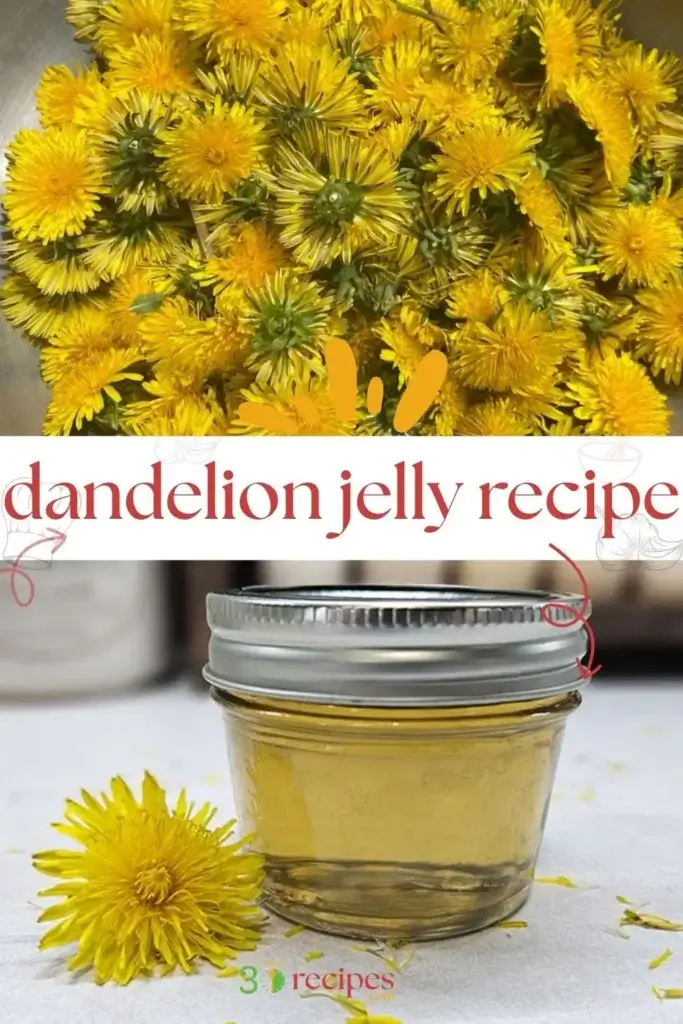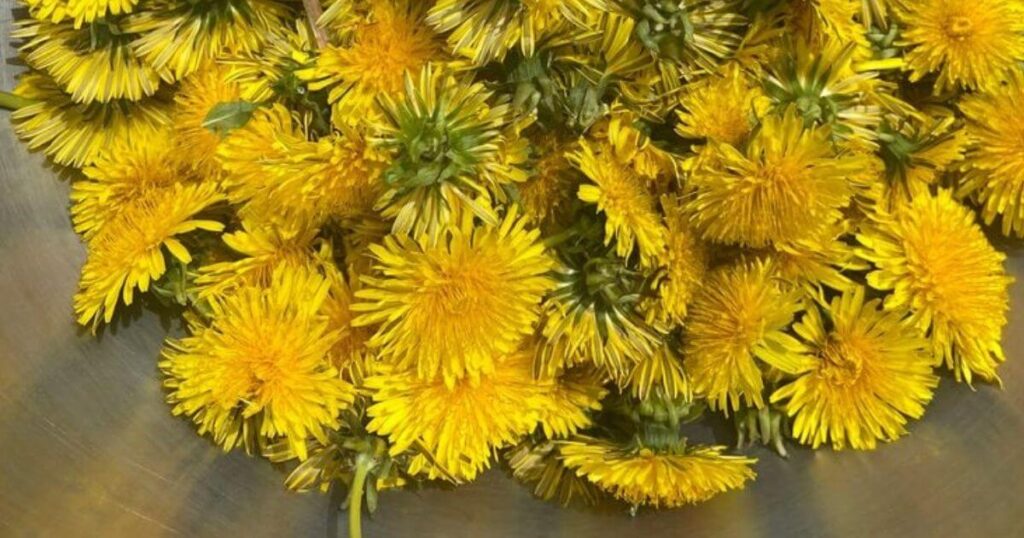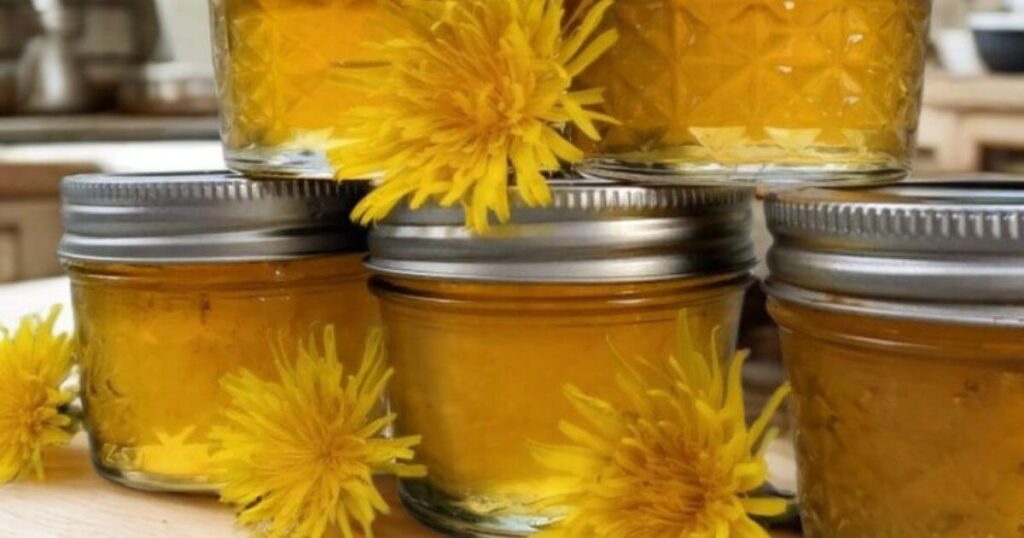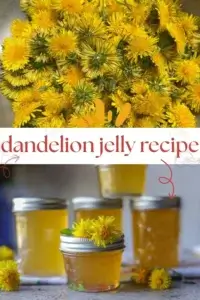Springtime has a way of creeping up on us—one minute it’s gloomy, and the next, the yard is bursting with bright little yellow blooms. If you’re anything like me, your first thought isn’t, “How can I turn these into dessert?” But let me tell you, once I discovered dandelion jelly, those sunny weeds became a golden treasure trove.
Table of Contents
Table of Contents
Now, before you wrinkle your nose at the idea of turning a backyard weed into something you’d slather on toast, hear me out. This isn’t just a jelly—it’s sunshine in a jar. Sweet, floral, and with a soft honey-like flavor, dandelion jelly feels like spring itself tucked between two pieces of warm toast.
Sunshine in a Jar: Dandelion Jelly for Sweet Moments
For busy moms trying to sneak in more outdoor time with the kiddos, this is the perfect nature-meets-kitchen project. Trust me, once you hand your little ones a bucket and ask them to gather dandelions “for jelly,” they’ll feel like backyard adventurers with a mission.
Let’s walk through why this recipe is a little magical—and yes, why you’ll totally want to make it every single spring.
Why You’ll Love This Dandelion Jelly
First off, it’s easy. Surprisingly so. Sure, pulling petals off a gallon bucket of dandelions sounds like a chore (and a little bit like a Disney side quest), but once you taste the jelly, you’ll see it’s totally worth it.
Here’s why this recipe might just earn a permanent spot in your springtime kitchen:
- Zero waste vibes: Turning “weeds” into something delicious? That’s kitchen magic.
- Kid-friendly fun: Dandelion picking is a perfect screen-free outdoor activity.
- Delightfully sweet: The flavor? Like wildflower honey kissed by a lemony breeze.
- Makes great gifts: Pour it into mason jars, tie on a cute ribbon, and boom—homemade hostess gifts or teacher appreciation jars.
Plus, it’s a total conversation starter. Imagine pulling out a jar at brunch and saying, “Oh, that’s dandelion jelly—I made it with the kids last weekend.” You’ll be the rustic kitchen goddess of your friend group.
Ingredients You’ll Need (And a Few Notes from My Kitchen)
Here’s what goes into your dandelion jelly—most of it’s already in your pantry:
- 3 ¼ cups water, or more if needed
- 4 cups lightly packed dandelion petals, divided
- 2 tablespoons lemon juice – adds that bright contrast
- 1 (1.75 oz) package powdered fruit pectin – to help it set beautifully
- 1 drop yellow food coloring – totally optional, but gives that golden glow
- 4 ½ cups white sugar – jelly needs sweetness, and this recipe delivers
Kitchen Tip from Grace:
Picking petals can be a little fussy, especially if you’re trying to avoid the bitter green parts. My advice? Pop on a podcast or have the kids help while you’re catching up on your favorite true crime or rom-com playlist. It turns a tedious task into a surprisingly therapeutic one.
Let’s Make It Together: Step-by-Step Instructions
Alright, apron on and jars ready—here’s how you make your dandelion jelly:
- Simmer the petals:
Bring a large pot of water to a simmer. Toss in 2 cups of dandelion petals and simmer them for 10 minutes. Use a slotted spoon to remove them, and strain the liquid over a bowl. Squeeze those petals to get every last drop of that golden goodness. Discard the used petals. - Repeat with the other 2 cups of petals. Yes, again. More petals = more flavor. Think of it as doubling down on spring.
- Measure the liquid:
After straining both batches, measure out 3 cups of dandelion-infused water. If you’re a little short, no worries—top it off with tap water. - Bring the flavor to life:
In a large pot, combine the dandelion water with lemon juice, pectin, and that little drop of yellow food coloring. Bring it to a full, rolling boil. - Sugar rush:
Add all 4½ cups of sugar at once. Stir constantly and bring it back to a rolling boil. Cook for about 1 minute, then remove from heat. If there’s any foam on top, just skim it off. - Jar it up:
Pour your hot jelly into sterilized jars, leaving about ¼ inch at the top. Run a clean knife along the sides to remove air bubbles, then wipe the rims and seal with lids and rings. - Water bath magic:
Process your jars in a boiling water bath for 7 minutes. Don’t skip this—it helps seal the jars properly so they can sit pretty on your pantry shelf. - Cool and seal:
Set the jars on a cloth-covered surface and let them cool for a full 24 hours. Check that each lid has sealed by pressing the center—if it doesn’t pop, you’re golden!
Everything You’re Wondering About Dandelion Jelly (And Then Some)
After sharing this dandelion jelly recipe with friends, neighbors, and one very skeptical brother-in-law, I’ve gotten every question under the sun—from “What does this taste like?” to “Wait, can I eat dandelions raw?” So let’s cover the most common ones you might be wondering too.

What does dandelion jelly taste like?
Short answer? Like floral honey with a hint of citrus.
It’s sweet and bright, with a gentle wildflower note that makes it perfect on toast, biscuits, or drizzled over goat cheese. If sunshine had a flavor, this would be it.
What part of the dandelion is used for jelly?
Just the petals!
Skip the green parts—they’re bitter and can throw off the flavor. You want those soft, yellow petals only. Think of them as nature’s golden confetti.
How do you eat dandelion jelly?
Oh, let me count the ways:
- Slathered on warm sourdough toast
- Drizzled over yogurt or cottage cheese
- Served with a cheese board (try brie or goat cheese—divine!)
- As a surprise filling in thumbprint cookies
- Or my favorite: swirled into warm oatmeal on a rainy morning
You really can treat it just like any fruit jelly—it plays well with both sweet and savory.
Can I make honey from dandelions?
Kind of! While it’s not technically honey (because, well, no bees), you can make a dandelion syrup that tastes remarkably similar. Dandelion jelly is very close in flavor—sweet, floral, and golden.
Does dandelion jelly go bad?
Eventually, yes—but not for a long time if stored correctly.
- Unopened and properly canned: It lasts up to 1 year in the pantry.
- Opened: Store it in the fridge and use within 3 weeks.
Make sure the seal on the jar is tight before storing, and always check for spoilage if anything seems off.
What are the benefits of eating dandelions?
You might be surprised, but dandelions are packed with nutrition. They contain:
- Antioxidants
- Vitamins A, C, and K
- Potassium and magnesium
They’re often used in herbal remedies for liver support, digestion, and even mild inflammation. While dandelion jelly is more for taste than health (hello, sugar!), it still brings some of that sunny plant goodness to the table.
Are there any risks or side effects?
Good question—dandelions are generally safe for most people, but there are a few exceptions:
- If you’re allergic to ragweed or similar plants, you might also react to dandelions.
- Some folks may experience an upset stomach or increased urination (yep, the old “wet-the-bed” folklore is based on this).
- If you’re on medications like diuretics or lithium, consult your doctor first.
Always harvest from unsprayed, clean areas—no roadside or park dandelions, please!
Can you eat dandelions raw?
Yes, you can! The leaves are often used in salads (think arugula-style bitterness), and the flowers can be eaten raw or cooked. Just be sure to clean them thoroughly and remove the green bits if using petals for sweet recipes like jelly.

Do dandelions reduce belly fat?
They’re not a miracle diet food, but dandelions have natural diuretic properties—which means they may help reduce water retention. Some herbalists use them in teas to support digestion and metabolism, but don’t expect magic. For real fat loss, it’s still diet + movement, I’m afraid.

What else can I make with dandelions?
Oh, so much! If this dandelion jelly recipe has you hooked, try:
- Dandelion tea – soothing and earthy
- Dandelion wine – a sweet, old-fashioned sip
- Fried dandelion fritters – just dip the blooms in batter and fry
- Dandelion pesto – using the leaves with garlic and parmesan
- Even dandelion vinegar for salads!
Who knew your lawn was basically a free farmer’s market?
How Dandelion Jelly Became a Sweet Spring Tradition
The first time I made dandelion jelly, I was just looking for a fun way to keep my daughter busy in the yard. But what started as a playful nature project turned into something so much sweeter—quite literally. Now, every spring, it’s become a must-do family ritual. She’s older now, but still insists on being the “chief petal picker.”
And that’s what I love about this jelly. It’s not just a spread—it’s a memory in a jar. Whether you’re sharing it with neighbors, packing it in school lunches, or saving a few jars for cozy winter breakfasts, this dandelion jelly recipe is a heartwarming reminder that joy often hides in the simplest places… like the weeds under your feet.
Grace’s Real-Life Tips for Dandelion Jelly
Before you dive in, here are a few lessons I’ve learned through (sticky) trial and error:
- More petals = more flavor. You can’t cheat this step. A gallon bucket of blooms usually yields just the right amount.
- Avoid bitter greens. It’s tempting to toss the whole flower in—but only use the yellow petals. The green bits make it taste like salad dressing gone rogue.
- Trust the process. The jelly may look watery at first, but it thickens beautifully as it cools. Don’t panic.
For even more petal-pulling tips and beautiful process photos, I love the homestead approach in this guide from Lonely Pines Farm. It’s charming and super informative if you’re new to jelly making.
Creative Ways to Use Your Dandelion Jelly
Once your jars are cooled and sealed, the real fun begins. Here are some chef-approved ideas for enjoying your golden bounty:
- Swirled into plain Greek yogurt with fresh berries
- Served with a soft cheese board (brie + jelly = magic)
- As a glaze over grilled chicken or pork
- Brushed onto warm biscuits or scones
- Or—dare I say—layered into a PB&J for a springtime twist
Curious how other families are doing it? Check out Mom’s classic dandelion jelly recipe on Baker’s Brigade for a sweet and simple variation passed down through generations. (Spoiler: it’s comfort in a jar.)
From Weed to Wonder: Why Dandelion Jelly Deserves the Hype
In a world of matcha lattes and trending TikTok pastas, you might wonder: Why is dandelion jelly suddenly everywhere? Well, the truth is—it’s not new. It’s just finally being rediscovered for what it is: an old-fashioned, humble, and truly delicious way to connect with nature and your kitchen.
If you’re craving a more self-reliant, sustainable approach to cooking, Ashley at Practical Self Reliance has a wonderfully in-depth writeup on foraging dandelions and creating jelly that speaks to the heart of homesteading. Her piece dives deep into harvesting ethics, flavor variations, and more.
Dandelion Jelly Is Just the Beginning…
If making your own jelly gave you that joyful I-can-do-this buzz, keep the creative kitchen vibes going with more nature-inspired and quick-prep recipes from the 30min kitchen:
- Spinach and Mushroom Quiche Recipe – springy and satisfying
- Best Sourdough Discard Pancakes – perfect with a dollop of dandelion jelly
- How to Make Marry Me Chicken Pasta (Step-by-Step) – because love is a dish best served saucy
- New York-Style Bacon, Egg & Cheese Bagel – morning magic that pairs with sweet jelly on the side
So next time you see a sea of yellow blooming across your lawn, don’t reach for the mower just yet. Reach for a bucket—and start something beautiful instead.
Dandelion Jelly for Sweet Spring Moments

Dandelion jelly is sweet, floral, and easy to make—turn backyard blooms into golden jelly with this step-by-step recipe perfect for springtime!
Type: Dessert, Spread, Preserve
Cuisine: American
Keywords: spring, edible flowers, homemade jelly, dandelion jelly recipe, foraging, backyard cooking, floral spread, homemade preserves, kid-friendly, natural foods
Recipe Yield: 5 cups (approx. 40 servings)
Calories: 92
Preparation Time: PT30M
Cooking Time: PT50M
Total Time: P1DT1H20M
Recipe Ingredients:
- 3 ¼ cups water (or more if needed)
- 4 cups lightly packed dandelion petals, divided
- 2 tablespoons lemon juice
- 1 (1.75 oz) package powdered fruit pectin
- 1 drop yellow food coloring (optional)
- 4 ½ cups white sugar
Recipe Instructions: Simmer 2 cups of dandelion petals in simmering water for 10 minutes. Strain and squeeze out liquid. Discard used petals. Repeat with the remaining 2 cups of petals. Measure out 3 cups of the dandelion water. Top off with water if needed. In a large pot, combine the dandelion water, lemon juice, pectin, and food coloring. Bring to a rolling boil. Add sugar all at once. Stir constantly. Return to a rolling boil and cook for 1 minute. Remove from heat and skim foam if needed. Pour hot jelly into sterilized jars, leaving ¼ inch space at the top. Remove air bubbles and seal. Process in a boiling water bath for 7 minutes. Cool jars on a towel and allow to set for 24 hours.
5


1 thought on “Dandelion Jelly for Sweet Moments”
Comments are closed.